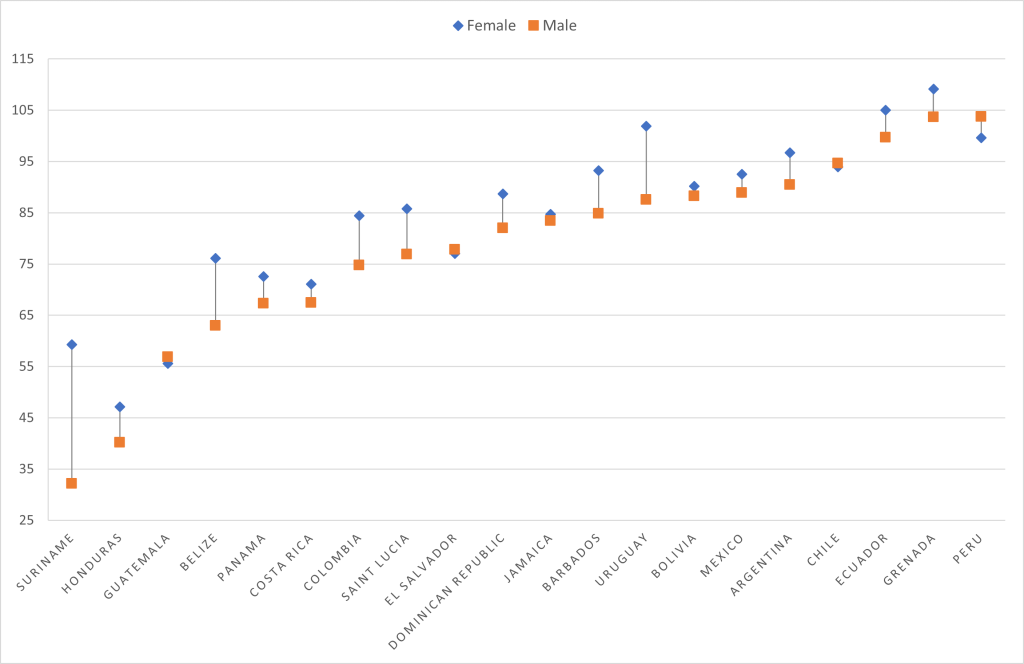 Niño escuchando la lección en una sala de clases en Guatemala.
Niño escuchando la lección en una sala de clases en Guatemala.
In the last two decades, Latin America and the Caribbean (LAC) has seen two of its biggest educational successes: one, gender parity in enrollment in primary school, with average net enrollment rates of 94 percent for both girls and boys in 2019; the other, a significant increase in the overall net enrollment in secondary education, going from 59 percent in 1990 to 77 percent in 2018.
However, in addition to secondary school enrollment remaining far from universal, a ‘reverse gender gap’ in enrollment and completion has taken place in the region: compared to girls and young women, boys and young men are at a higher risk of dropping out of secondary and tertiary education . In many LAC countries, boys have lower rates of enrollment and completion of secondary than that of girls, starting at the lower-secondary level.
Completion rates of lower-secondary school are lower for boys than for girls in most Latin American and Caribbean countries
Lower secondary completion rate, male/female (% of relevant age group), latest data 2019-2020

Men have lower tertiary enrollment rates than women in all Latin American and Caribbean Countries
Tertiary enrollment rate, male/female (% gross), latest data 2017-2020

In Caribbean countries, enrollment starts to diverge significantly against boys at upper secondary. In Jamaica, for example, while overall net attendance in upper secondary is low (58 percent only), more upper-secondary boys than girls are out of school (11.5 vs. 8.8 percent, respectively); this translates into a reverse gap in the promotion rate from grade 10 to 11, which was 86.5 percent for boys versus 90 percent for girls. Inequitable access to education continues at the tertiary level, where male, rural, and socioeconomically disadvantaged populations are less likely to attend.
In addition to the increased risk of dropout, boys also face educational underachievement in terms of lower learning outcomes . In LAC countries, girls outperform boys in reading, whereas boys outperform girls in mathematics but by a much smaller margin. Gender gaps in learning outcomes are also observed in the Caribbean: for example, more girls in the Organization of Eastern Caribbean States (OECS) countries participate in the high-stakes Caribbean Secondary Education Certificate (CSEC) exam, conducted at the end of secondary education, and girls are also more likely to attain passing grades.
While poverty accentuates educational underachievement for all, this relationship is even stronger for boys and young men. Underachievement in education also comes with a higher likelihood of engagement in risky behaviors, and worse future labor market outcomes.
Addressing boys’ increased risk to underachieve: What is the World Bank doing in LAC?
A new World Bank gender policy note on Reducing Boys’ School Dropout and Helping Boys at Risk provides more detail about the drivers of boys’ increased risk of underachievement in LAC, discusses evidence-based approaches to support retention of boys in school, and presents examples of how the Bank supports countries in addressing this phenomenon.
Through its support to country operations, the WBG is working to address the cross-cutting problem of boys at risk as a gender issue related to development challenges. Teacher training, early warning systems, and financial incentives are examples of activities that aim to promote the retention of boys in education and thus increase their chances of success later in life.
- Improving pedagogical practices by offering large-scale mentorship and training to teachers. Colombia has been implementing a program combining learning assessments and updated pedagogical practices. This program contains a remedial education and socioemotional learning component offering teachers effective differentiated-learning strategies for the classroom and tutoring in basic competencies to help students recover from individual learning losses (especially after the COVID-19 pandemic). These activities had a special focus on reducing the gender gaps in learning by improving boys’ reading proficiency and girls’ performance in math and science.
- Identifying students at risk of early dropout and providing targeted support. Through an enhanced early warning system, an education project in Guyana is planning to train teachers on how to identify at-risk students and how to respond with socioemotional counseling and academic support. While the project aims to boost the capacity of secondary school teachers overall, it incorporates activities specifically to raise boys’ interest in learning and school retention. For instance, low-cost communication campaigns will be used to inform students, and particularly boys, on wage returns to secondary education.
- Providing monetary incentives to students from poor households. The Youth Savings Program (Programa de Incentivo Educacional Poupança Jovem) in Piaui, Brazil, provides students in participating municipalities with an annual financial reward for each successfully completed year of secondary education. An additional condition for receiving the reward is participation in extracurricular activities, such as good citizenship, crime prevention, and gender equality programs.
Educational underachievement among boys and men is a pressing problem with far-reaching consequences for LAC and beyond. As such, this phenomenon deserves more attention from policymakers, academics, and communities, as well as more data and evidence.
Related link: LAC Evidence-Based Policy Notes: Reducing Boy’s School Dropout and Helping Boys at Risk




Join the Conversation